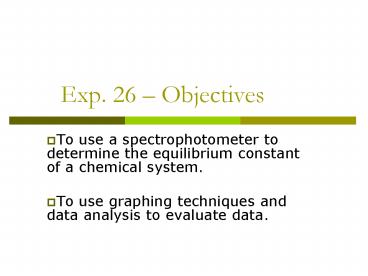Exp. 26 Objectives - PowerPoint PPT Presentation
1 / 10
Title:
Exp. 26 Objectives
Description:
... 26 Objectives. To use a spectrophotometer to determine the equilibrium constant of a chemical ... A.2. & A.3. Prepare a blank and zero the spectrophotometer. ... – PowerPoint PPT presentation
Number of Views:51
Avg rating:3.0/5.0
Title: Exp. 26 Objectives
1
Exp. 26 Objectives
- To use a spectrophotometer to determine the
equilibrium constant of a chemical system. - To use graphing techniques and data analysis to
evaluate data.
2
Exp. 26 Introduction
- Spectrophotometric analyses involve the
interaction of electromagnetic (EM) radiation
with matter. - The most common regions of the EM spectrum used
in analyses are the - UV
- Visible 400-700nm
- IR
3
Exp. 26 Introduction
- Every chemical substance produces its own unique
set of electronic, vibrational, and rotational
energy states. When EM radiation falls incident
upon an atom or molecule, the radiation (light)
absorbed is an energy equal to the difference
between two energy states in the atom or
molecule, placing the atom or molecule in an
excited state. The remainder of the EM radiation
(which is not absorbed) passes through the sample
and can be detected by a detector.
4
Exp. 26 Introduction
- The higher the concentration of the absorbing
species in the sample, the more EM radiation is
absorbed and the more intense is the
complementary transmitted radiation. - Several factors control the amount of EM
radiation that a sample absorbs - Molar absorptivity coefficient of the substance
- Thickness of the sample (cuvet)
- Concentration of the absorbing substance.
5
Exp. 26 Introduction
- Absorbance
- A (a)(b)(c) log Io/It log 100/T
- Graph A vs. . Fig. 26.4
- Standards
- Unknowns
6
Exp. 26 Introduction
- For the chemical system
- Fe3 SCN- ? FeNCS2
- Kc FeNCS2
- Fe3SCN-
7
Exp. 26 Introduction
- Kc is constant for a chemical system at a given
temperature. - The value (magnitude) of the equilibrium constant
(Kc) indicates the principal species (products
and reactants) that exist in the system at
equilibrium. - A large Kc tells us that the equilibrium lies to
the right, with a high concentration of products.
8
Exp. 26 Procedural Notes
- Part A read through all the procedure before
proceeding - A.1. Prepare a set of standards as shown in
Table 26.1. Mix well! - A.2. A.3. Prepare a blank and zero the
spectrophotometer. - A.4. Analyze the standards, recording the
absorbances (omit transmittance) - A.5. Graph the data
9
Exp. 26 Procedural Notes
- Part B
- B.1. Prepare the test solutions in your 150 mm
test tubes according to Table 26.2. Concentrate
on what youre doing! Dont mix up the pipets. - B.2. Recalibrate (zero) the instrument
- B.3. Mix the test solutions for approx. 30
seconds - B.4. Read the absorbance of the test solutions,
and, using the curve prepared in A.5, find the
concentration of FeNCS2 in the solutions. - B.5. Complete the calculations on the report
sheet.
10
Exp. 26 Report Sheet
- Questions 2, 3, 6
- This is a formal.































